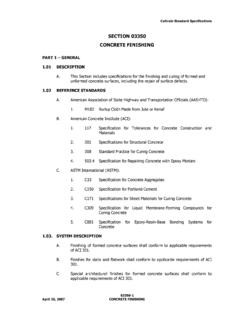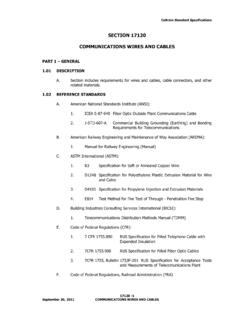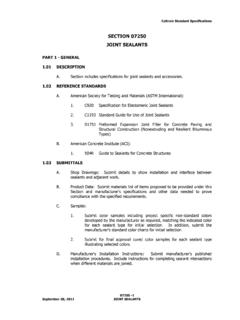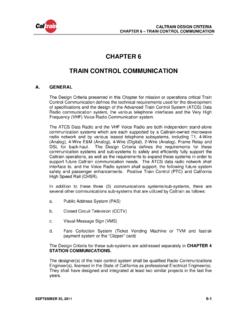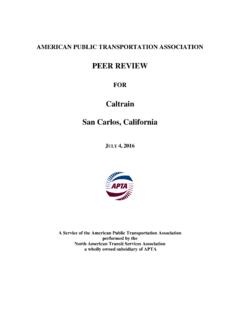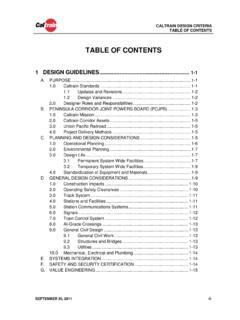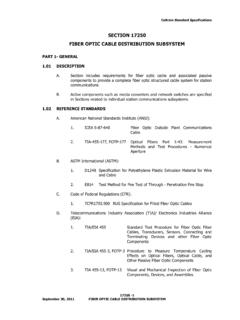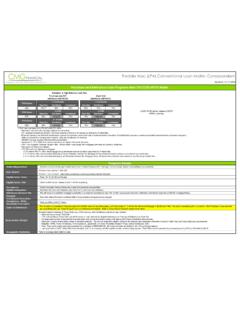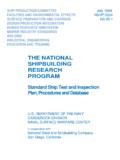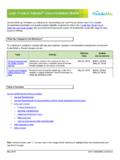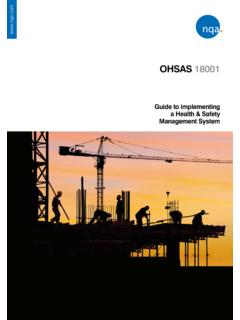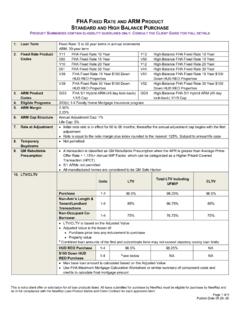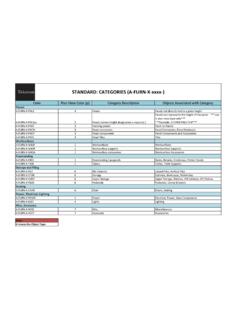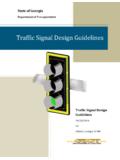Transcription of CHAPTER 7 GRADE CROSSINGS - caltrain.com
1 caltrain DESIGN CRITERIA CHAPTER 7 GRADE CROSSINGS SEPTEMBER 30, 2011 7-1 CHAPTER 7 GRADE CROSSINGS A. INTRODUCTION The term GRADE CROSSINGS or CROSSINGS in this document refers to all CROSSINGS at- GRADE . GRADE CROSSINGS are commonly referred in the technical literature and government publications as at- GRADE highway-rail CROSSINGS or simply highway-rail CROSSINGS or, the more recent pathway GRADE CROSSINGS . This CHAPTER also covers pedestrian GRADE CROSSINGS . GRADE CROSSINGS are intersections where vehicles and/or pedestrians cross train tracks at the same elevation, whereas at these locations the train always has the right of way. By definition an intersection is an area of potential conflict, , two (2) users cannot occupy the same space at the same time.
2 The term, motorized users or motorists, denote all types of vehicular drivers (automobiles, buses, trucks, motorcycles, etc.). The term non-motorized users or non-motorists refers to all pedestrians, which includes mobility impaired persons, wheelchair occupants, and bicyclists. Ideally, highway-rail GRADE CROSSINGS should not exist. For years one of the goals within the Federal Railroad Administration (FRA) is to eliminate all of the GRADE CROSSINGS . As that is not possible due to the large number of CROSSINGS , the more realistic goal is that a GRADE crossing that afford a safe, comfortable, and convenient passageway for all users. The GRADE crossing design consists of three (3) essential elements: safety, accessibility, and functionality.
3 In order to achieve these, the GRADE crossing requires a clearly defined and readily traversable pathway for both the motorist and pedestrian. In addition to the defined pathway, the GRADE crossing limits need to be clearly delineated. That is, those areas where a pedestrian or motorist can safely wait for a train to pass, or where a pedestrian or motorist has passed beyond the area of potential conflict must be readily apparent. One of the key consideration in the design is the crossing that would encourage lawful behavior. GRADE CROSSINGS may be either public or private. Public GRADE CROSSINGS are roadways that are under the jurisdiction of and maintained by a public authority.
4 Private GRADE CROSSINGS are privately owned, often located in an industrial area, and are intended for use by the owner or by the owner s licensees and invitees. Private GRADE CROSSINGS are not intended for public use and are not maintained by a public authority. caltrain DESIGN CRITERIA CHAPTER 7 GRADE CROSSINGS SEPTEMBER 30, 2011 7-2 GRADE crossing closures and/or replacement of GRADE CROSSINGS with GRADE separations will eliminate the majority of hazards. These two (2) options can be difficult to achieve. Closure of a GRADE crossing requires collaboration and affirmation from both the Local Agency and the public, which is a challenging proposition.
5 The GRADE separations are becoming more difficult to implement due to soaring costs, funding competition and limitations, and service impacts during construction. caltrain GENERAL POLICY caltrain has established general policy in regards to vehicular GRADE CROSSINGS , and pedestrians only GRADE CROSSINGS , as well as the related quiet zones. As a general policy, caltrain actively promotes the following approaches on GRADE CROSSINGS : a. Closure of under utilized existing CROSSINGS b. Consolidation of existing GRADE CROSSINGS c. Enhancement of safety, accessibility and comfort of existing CROSSINGS d. GRADE separation of existing CROSSINGS e. Adaptation of new technologies New GRADE CROSSINGS are not permitted.
6 The new crossing (s), if proposed shall only be considered in conjunction with closure of adjacent crossing (s), and shall be approved by the caltrain Deputy Director of Engineering. GRADE eliminations are the safest approach to the GRADE crossing enhancement and should be implemented as the preferred improvements for both vehicular and pedestrian CROSSINGS . For existing vehicular GRADE CROSSINGS , it is the policy of caltrain to systematically improve all CROSSINGS by installing pedestrian gates in all four (4) quadrants of vehicular GRADE CROSSINGS to enhance safety and accessibility. It is caltrain practice to closely collaborate with the CPUC (California Public Utilities Commission) and the Local Agencies having jurisdiction over the roadways to jointly evaluate and determine the improvements over the CROSSINGS .
7 These three stakeholders form a Diagnostic Team comprising of multi disciplines in the areas of civil and traffic engineering, and railroad signal engineering. More of this in the Section C, - DIAGNOSTIC TEAM. Quiet Zones Quiet zones refer to elimination of train horn sounding as the train approaches a GRADE crossing . The FRA in its Rule on the Use of Locomotive Horns at Highway-Rail GRADE crossing effective June 24, 2005 authorizes an option to maintain and/or establish quiet zones. Communities wishing to establish quiet zones must have in caltrain DESIGN CRITERIA CHAPTER 7 GRADE CROSSINGS SEPTEMBER 30, 2011 7-3 place supplemental or alternative safety measures to adequately compensate for the absence or reduction of train horn sounding.
8 Proposal for a quiet zone must take into account the fact that pedestrian CROSSINGS and vehicular CROSSINGS near caltrain stations require sounding a train horn to reactivate the crossing active warning devices after a station stop. Any proposed alternative method of reactivating GRADE CROSSINGS due to a quiet zone will require new equipment on-board all locomotives and cab cars, and will require conversion of all similar GRADE CROSSINGS . caltrain GRADE crossing SYSTEM caltrain has three (3) types of railroad GRADE CROSSINGS : vehicular GRADE CROSSINGS , pedestrian GRADE CROSSINGS , and emergency GRADE CROSSINGS . Emergency GRADE CROSSINGS provide access for caltrain approved maintenance vehicles, and for revenue operations on an emergency basis, as well as for potential future operations needs.
9 Emergency CROSSINGS are secured with gates and locks. They are not provided with active warning devices. All vehicular GRADE CROSSINGS within caltrain corridor have pedestrian CROSSINGS on either sides of the CROSSINGS . Additionally, caltrain also has pedestrians only at- GRADE CROSSINGS . All except two (2) of the CROSSINGS are located within the passenger stations. Not all of the passenger stations have pedestrian at- GRADE CROSSINGS . The stations without the at- GRADE CROSSINGS have pedestrian underpasses instead, or that the stations are of center boarding configuration. All of the GRADE CROSSINGS on caltrain are equipped with an active crossing warning system to provide notice that a train is approaching sufficient warning time for the motorist and pedestrian to stop short of the crossing , or if they have already entered the crossing , to safely continue past the area of potential conflict.
10 caltrain vehicular and pedestrian CROSSINGS utilize a track-circuit based device, which usually provides a constant time before the train reaches the crossing to activate bells, flashing lights, and automatic gate arms. The constant warning time devices control the flashing lights, automatic gates and bells, and the traffic preemption. caltrain developed its own standard practices for pedestrian CROSSINGS , which have been in effect since 1999. caltrain constantly adapts to new technologies of railroad signaling, partners with the CPUC and the Local Agency on the preemption diagnostics, and evaluates current practices and improvements at GRADE CROSSINGS regarding traffic control devices.
